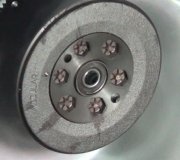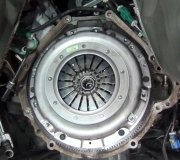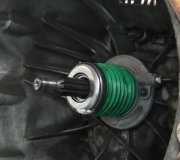I have a friend with a body shop who specializes in rebuilding smashed one and two-year-old Chrysler products. Straitening sheet metal takes less time for him than it takes to get the vehicle mounted on the frame rack, Your van uses the Uni-body design which is much stronger than a full frame, as long as it isn't suffering from excessive rust. Pulling something back to where it was is not going to seriously weaken it. What you must watch for are all those little dents and dimples in the corners of the rolled-up sheet metal. Those form crumple zones and stress-relieving points. When someone welds on extra bracing, that will make that area stronger, which can be a bad thing. That means in another crash, the stresses are going to be transferred to some other area that is not supposed to collapse under a controlled condition.
In this case, sheet metal that is pulled straight is better than sheet metal that is not shaped properly to match what passed crash-testing. Also, since the lower control arms are attached to the cross member which is bolted to the sheet metal, shifted sheet metal will result in shifted lower ball joints. That will make both wheels tip the same way, to the left or right on top. That's the main alignment angle, called "camber". Camber on most Chrysler products is easily adjustable by loosening the two lower strut mounting bolts and pushing the wheel to specs. That will take care of correcting camber, but it doesn't address the underlying reason why it changed.
Camber has a real big impact on pulling to one side when you let go of the steering wheel. Besides being in specs for good tire wear, camber on both sides has to be equal. (We usually make the left wheel just a fuzz higher to create a slight pull to the left to offset "road crown". That's roads leaning to the right so water runs off).
Here's where the next clinker comes in that even a lot of inexperienced alignment mechanics aren't aware of. That is a non-adjustable angle called "steering axis inclination", (SAI). If you stand in front of the van and draw an imaginary line between the upper and lower steering pivots, the angle of that line must be exactly the same on both sides. No spec is given but a typical angle might be 28 degrees. On your van the upper steering pivot is the upper strut mount. The lower pivot is always the lower ball joint.
Now imagine the crash has caused the front cross member to move to the passenger side by half an inch. The right lower control arm and ball joint have moved to the right a half inch, and the wheel will be tipped in on top. The opposite happens on the left side. That ball joint moves to the right too, and the bottom of the wheel does the same thing. The top is tipped out too much. At first the glaring problem the mechanic would see is the camber is terribly out-of-specs, and he might try to correct that. If there's enough range to the adjustments on both sides, he might make camber look perfect on the computer screen, but SAI hasn't been corrected first. With such bad readings that he started with, most mechanics will know to look for the cause. That could be as simple as another mechanic just replaced the struts, or he needs to look for evidence of a crash. Some customers seem to think it's a good idea to keep crash information secret, but that isn't going to make correcting the problems any easier or faster. When the mechanic knows the vehicle was crashed, SAI is one of the first things he will look at.
Correcting unequal SAI is often as simple as loosening and shifting the cross member to one side. As a point of interest, GM front-wheel-drive cars have their engines and transmissions removed by removing that cross member, and a real lot of people don't understand how critical it is to mark it first so it can be put back exactly the same way. Moving to either side by as little as 1/16" will create a car that has extremely miserable handling and will dart left and right unpredictably when driving over normal bumps in the road. Readjusting camber won't fix that.
Chrysler uses a different type of bolt to hold their cross members to the body, and shifting to one side isn't possible, but that doesn't mean they're immune to bent sheet metal. If you have a printout from a recent alignment, SAI will be shown for both front wheels. All computers measure that automatically when the mechanic is performing other procedures. It must be equal on both sides, generally within 0.2 degrees. If you find considerably more than that, you will have already noticed less-than-ideal handling. The goal now is to see what it will take to shift the cross member so the two struts tip more or less until they're equal, then have camber readjusted. If you find the cross member has to be moved to the passenger side, that will push the ball joint and bottom of the spindle that way too. That will move the wheel bearing too, resulting in the right inner cv joint extending under its spring pressure.
Now that I shared all that, don't get overly-excited yet about inner cv joint boots that don't look the same. Chrysler buys their half shafts from two or three different suppliers. They all interchange, but they do that in case one factory goes on strike or can't keep up production. When you buy replacement joints or boots, the dealer will ask you for the seven or eight-digit part number on the yellow sticker on the shaft to be sure they get you the right parts. The only definite way to be sure neither joint is bottomed out is to see how far you can push the outer joint toward the engine. Each one should move about an inch. Remember to never have the vehicle's weight on the wheel bearing when the axle nut is loose or not torqued to specs. Most call for 180 foot pounds, but some are as high as 240 foot pounds.
I've never heard of anyone trying to change the length of a half shaft because that would be a method of covering up the underlying problem that is still going to be there. Drive shaft shops do custom work for special applications like limousines, but another problem with half shafts is they usually have some type vibration damping built into the hollow tubes, and that can't be duplicated after a completed shaft is cut apart.
Monday, July 27th, 2015 AT 11:09 PM



